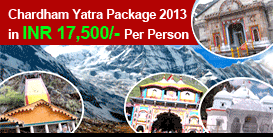
Uttarakhand Packages
RISHIKESH HILL STATION
Rishikesh is yet another centre of pilgrimage and tourist attraction for Indians as well as foreigners. Rishikesh is popularly known as the Yoga Capital of the World. Rishikesh is 28 kms from Haridwar on way to Badrinath and is situated at the foothills on either side of holy river Ganga and is surrounded by Shivalik ranges from three sides. Rishikesh complex consists of three distinct areas, known as Rishikesh, Muni-ki-Reti and Swargashram. The town is well known for modem and ancient Ashrams. In addition, it has temples and other places which are in one way or other connected with Puranic legends. It is said that when Raibhya Rishi did rigorous penances, the God appeared and the place was named 'Hrishikesh' and subsequently the place came to be known as Rishikesh. Bharat, brother of Lord Rama, also subjected himself to severe penances here and in his memory Bharat Temple was constructed. Temples are also dedicated to Lord Ram, Lakshman and Shatrughan. The other temples are Pushkar temple, Bharat temple, Rishikund and Raghunath temple. Thousands of pilgrims are visiting the place round the yea!. There are many spiritual Yoga and meditation centers located here which are regularly visited by large number of tourists from all over the world.
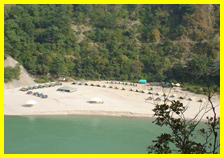
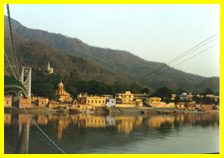
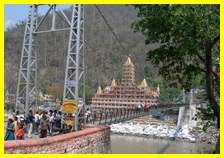
General Information
Area: 11.20 sq km.
Population: 29,145 (1981 census).
Altitude: 356 m.
Temperature: Summer 18.3 to 32.2° C and Winter 14.4 to 29° C.
Rainfall: 1,524 mm (average) June to September.
Best season to visit : April to June or September to October.
Clothing: Summer-Cotton and Winter -Heavy Woollens.
Language spoken: Hindi, Garhwali and English.
What to See in Rishikesh
Antibiotics Project at Virbhadra : 6.4 km. Permission to visit antibiotics plant is to be obtained from the General Manager, Antibiotics Plant, Virbhadra, Rishikesh.
Laxman Jhoola : It is a beautiful sight about 7 km north of Rishikesh. There was a hanging just rope bridge across river Ganga (without pillar) till 1889 which was rebuilt with iron ropes in 1939. The suspension bridge has a span of 140. Raghunathji's temple is the main attraction at Laxman Jhoola. Laxman is said to have visited this place and is believed to have done penance to wash his sins for having killed a Brahmin. The suspension bridge connects Rishikesh with Tapovan across river Ganga where a temple is dedicated to Laxman.
Triveni Ghat: 1.6 km. A bathing Ghat, where three streams of Ganga, Yamuna and Saraswati are believed to be flowing together underground. This is a sacred place where 'Pinda Shradha' is performed or food is offered to the departed soul. Evening Aarti (prayer) of goddess Ganga is also performed here.
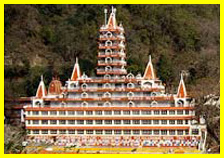 Swarga Ashram: 8 km. It is a quiet place on the left bank of the Ganges opposite to Shri Shivananda Ashram. Swarg Ashram can be reached either by crossing Ganga by boat or by another Ram/Shivanand suspension bridge since built across river Ganga. An idol of Shri Badrinath Ji is enshrined in the temple which is surrounded by forest. Pilgrims visiting Badrinath temple also pay their visit to Swarga Ashram. The temple and Dharamshala is maintained by Kali Kamliwala Kshetra enroute. In fact Swarga Ashram is a self-contained township with restaurants, shopping centers alongwith temple, parks, libraries, meditation centers and Ayurvedic dispensaries.
Swarga Ashram: 8 km. It is a quiet place on the left bank of the Ganges opposite to Shri Shivananda Ashram. Swarg Ashram can be reached either by crossing Ganga by boat or by another Ram/Shivanand suspension bridge since built across river Ganga. An idol of Shri Badrinath Ji is enshrined in the temple which is surrounded by forest. Pilgrims visiting Badrinath temple also pay their visit to Swarga Ashram. The temple and Dharamshala is maintained by Kali Kamliwala Kshetra enroute. In fact Swarga Ashram is a self-contained township with restaurants, shopping centers alongwith temple, parks, libraries, meditation centers and Ayurvedic dispensaries.
Gita Bhawan : 8 km. Constructed by Geeta Bhawan Trust Gorakhpur in 1944 adjacent to Swarga Ashram complex. The temple and group of buildings have Gita and Ramayana inscribed on its walls. The Bhawan is controlled by a body of trustees, who are affiliated to the Gita Press, Gorakhpur. The mission of the trust is to serve the society through normal and spiritual education.
Baba Kali Kamliwala Panchayati Kshetra : It is one of the oldest institutions, founded by Shri Baba Vishuddha Nanda Ji and now run by a Trust. The main office of the institution is at Rishikesh and it has branches at all the pilgrim centres in Garhwal hills. They provide lodging and boarding facilities to the pilgrims all along the route even at the higher altitude of the Himalayas upto Kailash.
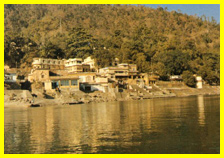 Shri Sivananda Ashram and Divine Life Society: 2.5 km from Rishikesh Bus stand on Rishikesh-Laxman Jhoola Road. This Ashram was established in 1936 by Shri Swami Sivananda Ji Maharaj, the renowned Yogi of India. A hospital is run here and experienced doctors attend the sick tree of charge. Arrangements of food and bedding for sick and ailing are made tree. In the serene atmosphere of the Ashram a large number of saints and devotees are leading holy lives and practicing Yoga here. The members of the Society believe in one religion and have vowed to help people in distress.
Shri Sivananda Ashram and Divine Life Society: 2.5 km from Rishikesh Bus stand on Rishikesh-Laxman Jhoola Road. This Ashram was established in 1936 by Shri Swami Sivananda Ji Maharaj, the renowned Yogi of India. A hospital is run here and experienced doctors attend the sick tree of charge. Arrangements of food and bedding for sick and ailing are made tree. In the serene atmosphere of the Ashram a large number of saints and devotees are leading holy lives and practicing Yoga here. The members of the Society believe in one religion and have vowed to help people in distress.
Other Places of Interest
Ashram and Yoga Centres: Yoga Niketan Laxman Thoola, Yoga Sadan Ashram Rishikesh, Shri Vithala Ashram and Transcendental Meditation Centres of Maharishi Mahesh Yogi Shankaracharya Nagar, Ved Niketan and Yoga study centre.
Temples: Raghunath temple, Bharat temple, Pushkar temple, Shatrughan temple, Laxman temple, Sheshdhara, Rishikund and Bhagirath temple.
Excursion Visits
Narendra Nagar: The hill station of Narendra Nagar is 15 kms trom the foothill town of Rishikesh in Tehri district on the way to the holy shrines of Gangotri and Yamnotri. Narendra nagar was the capital of former Tehri State and the palaces of the former Maharaja Narendra Shah are located here. The offices of Tehri district are also located here. Kunjpura is an attractive place on top of a hillock near Narendra Nagar which provides beautiful panoramic view of the Himalayas.
Chamba : 62 kms trom Rishikesh. While staying in Rishikesh, visitors can go upto Chamba which is very pleasant during summer months. Chamba provides an impressive view of the Himalayan peak Bandarpoochh on a clear day. A tTuit belt has since been developed in Chamba and apples and apricots are grown here in plenty A tourist bungalow is available for spending a night. More about Chamba
Garur Chatti : 8 kms trom Laxman Jhoola. A temple is here which is dedicated to Lord Garur Maharaj.
Bhootnath Cave: 3 kms trom Laxman Thoola. An attractive place both for pilgrims and tourists as well as adventurers.
Neel Kanth Mahadev : 1675 m. This temple is dedicated to Neelkanth Mahadev (Lord Shiva) which is about 22 kms from Laxman Jhoola. According to mythology, Lord Shiva had consumed the effluent poison produced after Sagar manthan which had turned his throat blue and thus this place came to be known as Neelkanth Mahadev or Shiva with Blue throat. While going upto Neelkanth Mahadev one can have a wide spread view of Himalayan peaks, Bhabar forests and plains below. Pilgrims mostly come here during the month of July/August.
How to Reach Rishikesh
Air: The nearest air-port is Jolly Grant air strip (18 kms) on Rishikesh-Dehra Dun Road which is connected by air service with Delhi.
Rail: Rishikesh is connected with Haridwar by rail and Haridwar is connected by long distance trains to Delhi, Bombay, Calcutta, Ujjain, Gorkhapur and Amritsar.
Road: Rishikesh is connected by road and regular Bus service with Agra (392 kms), Dehra Dun (43 kms), Delhi (238 kms), Haridwar (24 kms), Mussoorie (78 kms), Badrinath (298 kms), Kedamath (223 kms), Yamnotri , (222 kms), Gangotri (235 kms), Chandigarh (252 kms) and Uttarkashi (154 kms). Bus Stands: Roadways and Yatri Bus Stand.
Taxies: Are available on all Bus routes.
Local transport: Taxies, Three wheeler autos and Tongas as well as regular City Bus service are available in Rishikesh



General Information
Area: 11.20 sq km.
Population: 29,145 (1981 census).
Altitude: 356 m.
Temperature: Summer 18.3 to 32.2° C and Winter 14.4 to 29° C.
Rainfall: 1,524 mm (average) June to September.
Best season to visit : April to June or September to October.
Clothing: Summer-Cotton and Winter -Heavy Woollens.
Language spoken: Hindi, Garhwali and English.
What to See in Rishikesh
Antibiotics Project at Virbhadra : 6.4 km. Permission to visit antibiotics plant is to be obtained from the General Manager, Antibiotics Plant, Virbhadra, Rishikesh.
Laxman Jhoola : It is a beautiful sight about 7 km north of Rishikesh. There was a hanging just rope bridge across river Ganga (without pillar) till 1889 which was rebuilt with iron ropes in 1939. The suspension bridge has a span of 140. Raghunathji's temple is the main attraction at Laxman Jhoola. Laxman is said to have visited this place and is believed to have done penance to wash his sins for having killed a Brahmin. The suspension bridge connects Rishikesh with Tapovan across river Ganga where a temple is dedicated to Laxman.
Triveni Ghat: 1.6 km. A bathing Ghat, where three streams of Ganga, Yamuna and Saraswati are believed to be flowing together underground. This is a sacred place where 'Pinda Shradha' is performed or food is offered to the departed soul. Evening Aarti (prayer) of goddess Ganga is also performed here.
 Swarga Ashram: 8 km. It is a quiet place on the left bank of the Ganges opposite to Shri Shivananda Ashram. Swarg Ashram can be reached either by crossing Ganga by boat or by another Ram/Shivanand suspension bridge since built across river Ganga. An idol of Shri Badrinath Ji is enshrined in the temple which is surrounded by forest. Pilgrims visiting Badrinath temple also pay their visit to Swarga Ashram. The temple and Dharamshala is maintained by Kali Kamliwala Kshetra enroute. In fact Swarga Ashram is a self-contained township with restaurants, shopping centers alongwith temple, parks, libraries, meditation centers and Ayurvedic dispensaries.
Swarga Ashram: 8 km. It is a quiet place on the left bank of the Ganges opposite to Shri Shivananda Ashram. Swarg Ashram can be reached either by crossing Ganga by boat or by another Ram/Shivanand suspension bridge since built across river Ganga. An idol of Shri Badrinath Ji is enshrined in the temple which is surrounded by forest. Pilgrims visiting Badrinath temple also pay their visit to Swarga Ashram. The temple and Dharamshala is maintained by Kali Kamliwala Kshetra enroute. In fact Swarga Ashram is a self-contained township with restaurants, shopping centers alongwith temple, parks, libraries, meditation centers and Ayurvedic dispensaries.Gita Bhawan : 8 km. Constructed by Geeta Bhawan Trust Gorakhpur in 1944 adjacent to Swarga Ashram complex. The temple and group of buildings have Gita and Ramayana inscribed on its walls. The Bhawan is controlled by a body of trustees, who are affiliated to the Gita Press, Gorakhpur. The mission of the trust is to serve the society through normal and spiritual education.
Baba Kali Kamliwala Panchayati Kshetra : It is one of the oldest institutions, founded by Shri Baba Vishuddha Nanda Ji and now run by a Trust. The main office of the institution is at Rishikesh and it has branches at all the pilgrim centres in Garhwal hills. They provide lodging and boarding facilities to the pilgrims all along the route even at the higher altitude of the Himalayas upto Kailash.
 Shri Sivananda Ashram and Divine Life Society: 2.5 km from Rishikesh Bus stand on Rishikesh-Laxman Jhoola Road. This Ashram was established in 1936 by Shri Swami Sivananda Ji Maharaj, the renowned Yogi of India. A hospital is run here and experienced doctors attend the sick tree of charge. Arrangements of food and bedding for sick and ailing are made tree. In the serene atmosphere of the Ashram a large number of saints and devotees are leading holy lives and practicing Yoga here. The members of the Society believe in one religion and have vowed to help people in distress.
Shri Sivananda Ashram and Divine Life Society: 2.5 km from Rishikesh Bus stand on Rishikesh-Laxman Jhoola Road. This Ashram was established in 1936 by Shri Swami Sivananda Ji Maharaj, the renowned Yogi of India. A hospital is run here and experienced doctors attend the sick tree of charge. Arrangements of food and bedding for sick and ailing are made tree. In the serene atmosphere of the Ashram a large number of saints and devotees are leading holy lives and practicing Yoga here. The members of the Society believe in one religion and have vowed to help people in distress. Other Places of Interest
Ashram and Yoga Centres: Yoga Niketan Laxman Thoola, Yoga Sadan Ashram Rishikesh, Shri Vithala Ashram and Transcendental Meditation Centres of Maharishi Mahesh Yogi Shankaracharya Nagar, Ved Niketan and Yoga study centre.
Temples: Raghunath temple, Bharat temple, Pushkar temple, Shatrughan temple, Laxman temple, Sheshdhara, Rishikund and Bhagirath temple.
Excursion Visits
Narendra Nagar: The hill station of Narendra Nagar is 15 kms trom the foothill town of Rishikesh in Tehri district on the way to the holy shrines of Gangotri and Yamnotri. Narendra nagar was the capital of former Tehri State and the palaces of the former Maharaja Narendra Shah are located here. The offices of Tehri district are also located here. Kunjpura is an attractive place on top of a hillock near Narendra Nagar which provides beautiful panoramic view of the Himalayas.
Chamba : 62 kms trom Rishikesh. While staying in Rishikesh, visitors can go upto Chamba which is very pleasant during summer months. Chamba provides an impressive view of the Himalayan peak Bandarpoochh on a clear day. A tTuit belt has since been developed in Chamba and apples and apricots are grown here in plenty A tourist bungalow is available for spending a night. More about Chamba
Garur Chatti : 8 kms trom Laxman Jhoola. A temple is here which is dedicated to Lord Garur Maharaj.
Bhootnath Cave: 3 kms trom Laxman Thoola. An attractive place both for pilgrims and tourists as well as adventurers.
Neel Kanth Mahadev : 1675 m. This temple is dedicated to Neelkanth Mahadev (Lord Shiva) which is about 22 kms from Laxman Jhoola. According to mythology, Lord Shiva had consumed the effluent poison produced after Sagar manthan which had turned his throat blue and thus this place came to be known as Neelkanth Mahadev or Shiva with Blue throat. While going upto Neelkanth Mahadev one can have a wide spread view of Himalayan peaks, Bhabar forests and plains below. Pilgrims mostly come here during the month of July/August.
How to Reach Rishikesh
Air: The nearest air-port is Jolly Grant air strip (18 kms) on Rishikesh-Dehra Dun Road which is connected by air service with Delhi.
Rail: Rishikesh is connected with Haridwar by rail and Haridwar is connected by long distance trains to Delhi, Bombay, Calcutta, Ujjain, Gorkhapur and Amritsar.
Road: Rishikesh is connected by road and regular Bus service with Agra (392 kms), Dehra Dun (43 kms), Delhi (238 kms), Haridwar (24 kms), Mussoorie (78 kms), Badrinath (298 kms), Kedamath (223 kms), Yamnotri , (222 kms), Gangotri (235 kms), Chandigarh (252 kms) and Uttarkashi (154 kms). Bus Stands: Roadways and Yatri Bus Stand.
Taxies: Are available on all Bus routes.
Local transport: Taxies, Three wheeler autos and Tongas as well as regular City Bus service are available in Rishikesh




















